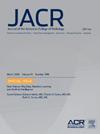Electronic Health Record Improvements to Reduce Emergency Department CT Prescan Times at a Safety-Net Hospital
IF 5.1
3区 医学
Q1 RADIOLOGY, NUCLEAR MEDICINE & MEDICAL IMAGING
引用次数: 0
Abstract
Introduction
CT is a cornerstone of radiologic imaging in the emergency department (ED), and its utilization has increased over time. CT turnaround times remain a frequent focus for improvement initiatives, especially in resource-limited safety net hospitals (SNHs). Because of the critical nature of CT imaging in the care of acutely ill ED patients and significant resource limitations SNHs face, SNHs must focus on process improvements, ideally that unburden their technologists, over additional resources to meet increasing volumes and rising expectations. In this study, we describe electronic health record (EHR) improvements to reduce the adult ED CT prescan interval by unburdening the CT technologists. Specifically, we hypothesized that by focusing on EHR improvements we would significantly reduce ED CT order-to-begin times and ED CT order-to-begin time variability.
Methods
Five EHR-based interventions were conceptualized and implemented by an interdisciplinary team of radiologists, CT technologists, ED physicians, and ED registered nurse leadership: examination order pick lists, integrated screening policies, technologist protocoling, CT Technologist Details tab, and banners for communication. A pre- and postintervention retrospective review was performed from January 1, 2021, through June 30, 2023. All CT examinations done on adults (≥18 years old), on either of the two hospital CTs, were included. Project periods were 6 months long and included preintervention, intervention, postintervention, and two additional sets of postintervention data: sustainment period 1 and sustainment period 2. Examination order and examination begin times were collected from the Epic EHR (Epic Systems, Madison, Wisconsin). Comparison of examination order-to-begin times pre- and postintervention were made using Wilcoxon’s rank-sum test analysis.
Results
In all, 62,540 CTs were performed during the 30 months of data collection: 11,499 preintervention, 12,475 intervention, 12,496 postintervention, 13,062 sustainment 1, and 13,008 sustainment 2. Median order-to-begin times decreased by 16 min after the implementation of the first three interventions in July 2021 and decreased by 13 min after the last two interventions in December 2021. Overall, the five selected interventions reduced ED CT prescan examination order-to-begin times by 46.6% (69 versus 37 min, P < .001) and interquartile range variability by 38.0%, demonstrating the effectiveness of EHR improvements.
Discussion
EHR improvements were effective in reducing ET CT prescan times and variability by unburdening CT technologist and improving ED CT performance.
改进电子健康记录以减少安全网医院急诊科CT扫描时间。
简介:CT是急诊科放射学成像的基石,其应用随着时间的推移而增加。CT周转时间仍然是改进举措的重点,特别是在资源有限的安全网医院(SNH)。由于CT成像在急诊患者护理中的关键性质以及snh面临的重大资源限制,snh必须专注于流程改进,理想情况下减轻技术人员的负担,而不是额外的资源来满足不断增长的容量和不断增长的期望。在本研究中,我们描述了电子健康记录(EHR)的改进,通过减轻CT技术人员的负担来缩短成人ED CT预扫描间隔。具体来说,我们假设,通过关注电子病历的改进,我们将显著减少ED CT订货开始时间和ED CT订货开始时间的可变性。方法:由放射科医生、CT技术人员、急诊科医生和急诊科注册护士领导组成的跨学科团队构思并实施了五种基于电子磁共振的干预措施:检查顺序选择清单、综合筛查政策、技术人员协议、CT技术人员详细信息标签和沟通横幅。从2021年1月1日至2023年6月30日进行了干预前和干预后的回顾性回顾。所有对成人(≥18岁)进行的CT检查,包括两家医院CT中的任何一家。项目周期为6个月,包括干预前、干预后、干预后以及另外两组干预后数据:维持期1和维持期2。考试顺序和考试开始时间从Epic EHR中收集。采用Wilcoxon秩和检验分析比较干预前后的考试开始时间。结果:在30个月的数据收集中,共进行了62540次CT检查:干预前11499例,干预后12496例,维持1期13062例,维持2期13008例。在2021年7月实施前三次干预措施后,订单开始时间中位数减少了16分钟,在2021年12月实施最后两次干预措施后,订单开始时间中位数减少了13分钟。总体而言,五种选择的干预措施减少了ED CT预扫描检查的顺序开始时间46.6% (69 vs 37分钟)。讨论:电子健康记录的改进有效地减少了ET CT预扫描时间和变异性,减轻了CT技术人员的负担,提高了ED CT的性能。
本文章由计算机程序翻译,如有差异,请以英文原文为准。
求助全文
约1分钟内获得全文
求助全文
来源期刊

Journal of the American College of Radiology
RADIOLOGY, NUCLEAR MEDICINE & MEDICAL IMAGING-
CiteScore
6.30
自引率
8.90%
发文量
312
审稿时长
34 days
期刊介绍:
The official journal of the American College of Radiology, JACR informs its readers of timely, pertinent, and important topics affecting the practice of diagnostic radiologists, interventional radiologists, medical physicists, and radiation oncologists. In so doing, JACR improves their practices and helps optimize their role in the health care system. By providing a forum for informative, well-written articles on health policy, clinical practice, practice management, data science, and education, JACR engages readers in a dialogue that ultimately benefits patient care.
 求助内容:
求助内容: 应助结果提醒方式:
应助结果提醒方式:


